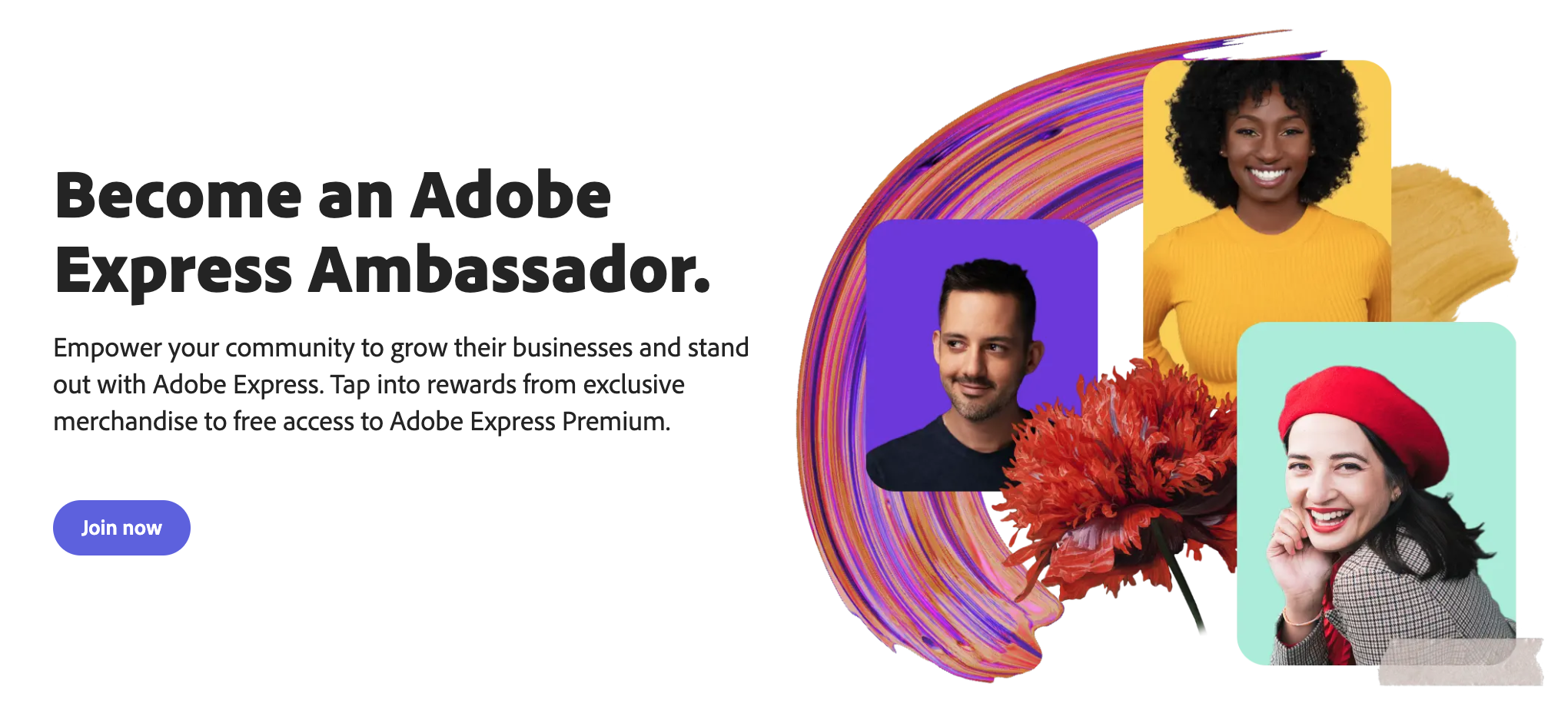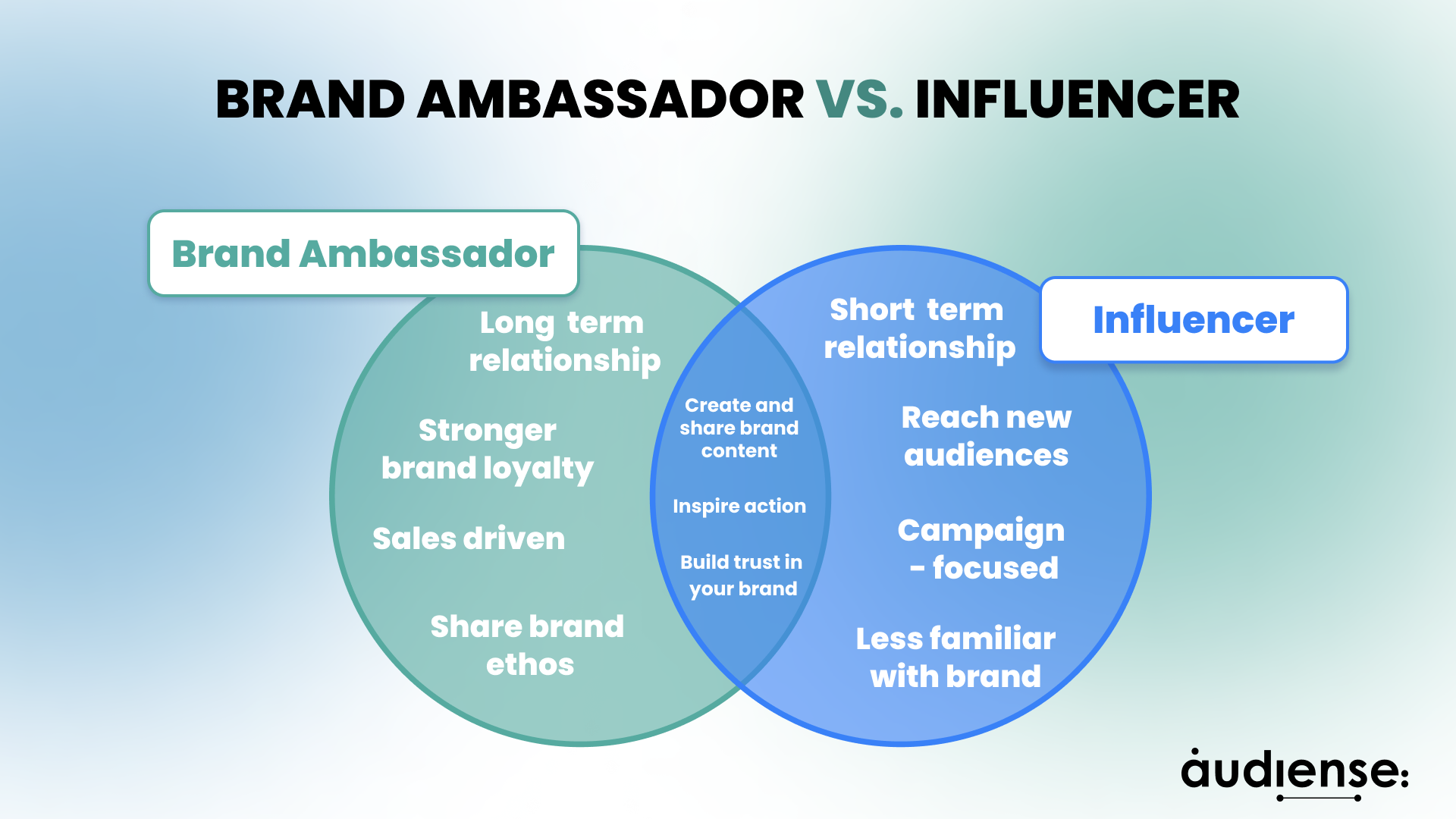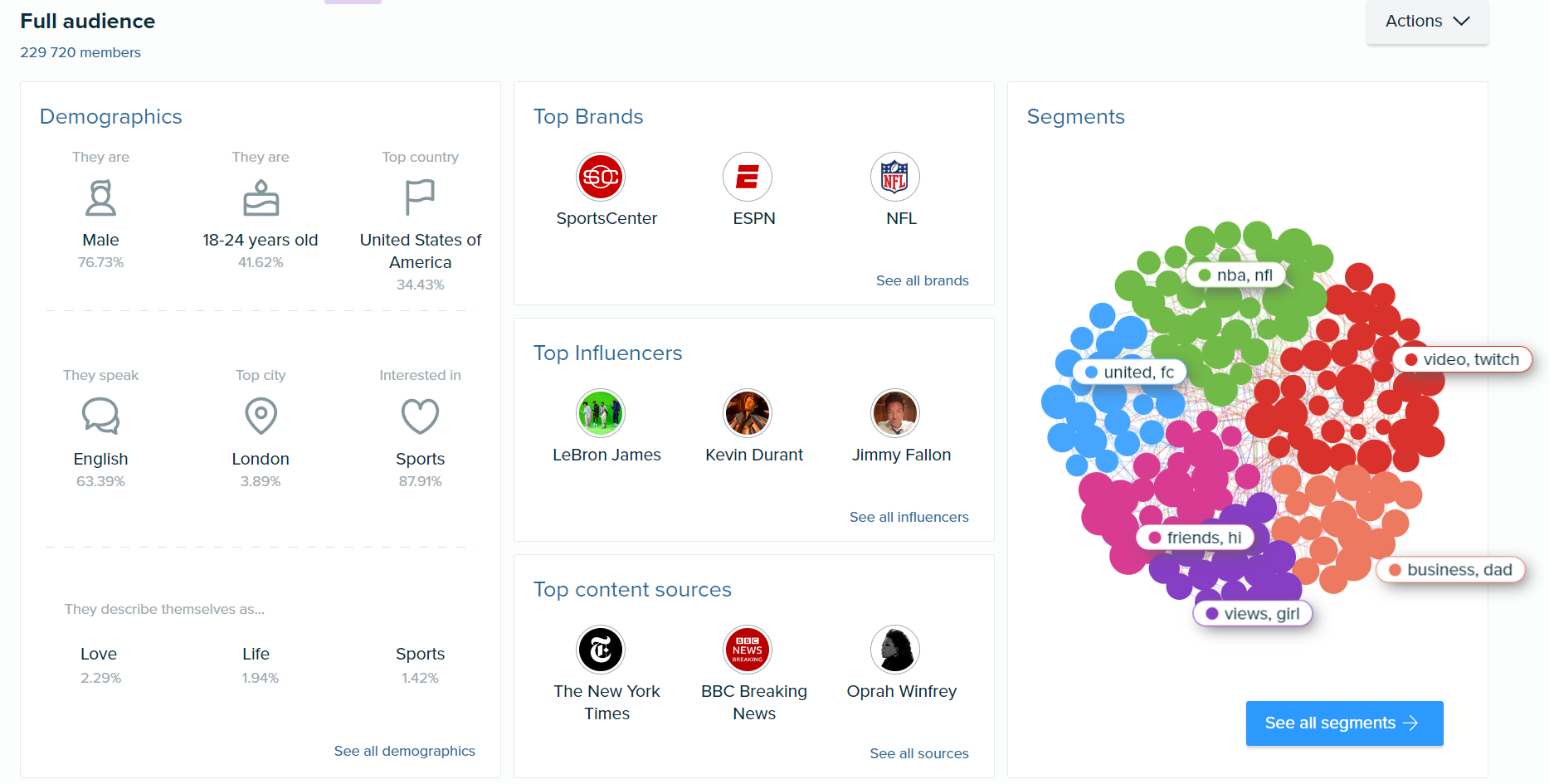Brand Ambassador or Influencer - Which is right for my business?
The creator economy has experienced an astounding surge, with individuals leveraging platforms like Patreon, TikTok,, and Instagram to generate significant earnings.
Many of the highest earners across these platforms aren’t companies or traditional celebrities, but talented creators who captivate audiences to build loyal online followings. These people may have niche expertise, or simply an entertaining personality, but the core value of these creators is their ability to connect brands with new consumer segments.
The global creator economy is estimated to be a $100-billion industry, and estimates put the number of contributors at well over 50 million.
Brands across industries including Adobe , Nike, and HelloFresh regularly partner with creators to reap the benefits of these unique collaborations. Chances are that the leading competitors in your space are looking to partner with creators as well.

The question now moves from whether or not to capitalize on this trend, to how you will do it successfully. The step in this process is to determine which type of creator partnership works best for your company:
Brand ambassador or influencer?
What’s the difference, and how do you choose? Read on to discover the nuances of each option and how to make the right decision for your brand.
What's the difference between a brand ambassador and an influencer?
At the most basic level, a brand ambassador is someone who represents a company’s brand for the long term, typically showing a deeper connection to the product and brand they partner with. Influencers on the other hand, use their social following to promote multiple brands or products through channels like Instagram, TikTok, and YouTube.
If you are looking for someone who can act as an extension of your brand and help build up a solid audience over time, brand ambassadors are the better play. If you want an immediate boost in brand exposure and conversions, influencers will likely be more effective.
Here are some stats on how influencers and brand ambassadors contribute to the value of the creator economy:
- The influencer marketing industry is projected to reach $21.1 billion in 2024.
- There are over 10,000 brand ambassadors employed in the United States alone
- 68% of surveyed brands are looking to increase their influencer marketing spend in 2023
- Over half of established brands already use ambassador programs to build a deeper connection between creators and their audience
- Creators with smaller audiences earn about 60% more engagement than macro influencers
Clearly, both of these creator types are having a major impact on the marketing strategies across all industries and end customers. So, now the question you need to answer is this: Which one is right for your business?
This will largely depend on your specific goals and the resources you have available, but to understand these differences a bit better, let’s dive into each of these creator types.
What does a brand ambassador do?
A brand ambassador is an individual who acts as a representative of a company's product and brand. They are responsible for promoting the brand and engaging with consumers in order to increase awareness, build community, and ultimately drive sales.
Brand ambassadors typically have some level of authority or expertise in the industry of their brand partners, although they are also talented communicators. They use their networking skills to create meaningful relationships with customers through digital campaigns, live events and other interactions, as well as other creative ways to spread the word about their brand.
With social media becoming such a powerful tool to reach consumers, good brand ambassadors also know how to engage with audiences on these platforms. For instance, brands like Lululemon, Red Bull, and Bumble all use brand ambassador programs that target specific subsections of their own audience who are most likely to spread the brand. Red Bull's Student Marketeer program has 4000 ambassadors worldwide, helping them stay relevant to their key audience of young adults.

Brand ambassadors are paid in a variety of ways. Depending on the agreement between the brand and the ambassador, payment can be made in the following ways:
- Cash
- Product discounts
- Free products
- Combination of the above
Cash payments are usually based on performance metrics such as sales generated, social media followers gained, or other agreed-upon goals. However, it’s also possible for brand ambassadors to be brought on in a salary or retainer-based arrangement. Ultimately, how a brand ambassador is paid depends on the agreement between the brand and the ambassador.
What does an influencer do?
Like a brand ambassador, the key role of an influencer is to create strong connections between an audience segment and your company.
The advantage of an influencer is that they have an engaged following on social media that they can leverage to promote products in unique and creative ways. They typically have an interesting perspective or personality that resonates with their audience, although they can also have expertise in a given field.
Although audience size can be an important metric, it’s increasingly clear that micro- and nano-influencers — creators with audiences under 10,000 — are some of the most effective creators in terms of brand promotion.
Influencers typically promote products through content creation, such as videos or stories on Instagram or posts on Twitter and other platforms. Their posts usually feature the product they are promoting and usually include tags for the product’s website. They may also link to the product’s website in their bio or profile description.
Influencers can also include branded hashtags when posting promotional content so users can easily find more information about the product being promoted. For example, NordVPN uses prominent TikTok creators, a strategy that has helped #nordvpn achieve over 149 million views.
-1.png?width=1999&height=1001&name=image1%20(1)-1.png)
In terms of compensation, influencers are usually paid either with free products or in cash payments based on performance metrics like sales generated or followers gained. For example, if an influencer promotes a certain brand’s product but doesn’t generate any sales from it then they may get paid in free merchandise instead of cash.
The benefits of working with influencers vs brand ambassadors
When it comes to promoting your brand and marketing to a particular target audience, influencers and brand ambassadors can be very valuable resources. Both are able to generate excitement, prestige, and awareness for a product or service.
However, influencers may have wider reach due to their larger network of followers, while brand ambassadors offer more presence in terms of engagements and interactions with consumers. Influencers specialize in delivering short-term campaigns that get people talking about your product or service, giving it a boost on social media channels.

Brand ambassadors focus more on developing relationships with consumers over the long term as well as maintaining positive relationships between your business and customers. In either scenario, it’s beneficial to establish clear expectations and goals from the outset so that each party knows what is required from them and how they need to deliver results.
When working with influencers, businesses have the ability to tap into larger groups of target audiences due to their bigger reach and engagement. On the other hand, brand ambassadors tend to have more knowledge about the details of your products and services which can help sway undecided customers.
Many companies combine the two strategies for maximum benefit so that it reaches a wider audience while still providing more detailed information via direct interactions from brand ambassadors.
How do you find a brand ambassador or influencer to work with?
For your brand ambassador or influencer campaign to be successful, you need to identify the creator who will resonate most with your audience segments. One of the best tools for accomplishing this is Audiense Insights — the consumer segmentation and analysis tool.
Audiense Insights allows you to break down large digital audiences, sports enthusiasts, for instance, to find the social profiles and creators who have the most influence on them.

Here are the steps for using Audiense for your brand ambassador vs influencer research:
- Set up a free Audiense Insights account
- Create a new report based on the topics and demographics
- Select the affinity segmentation toggle
- Set the parameters for your search
- Launch the report
- Go the the “Influencer” column of the report
Based on whether you are looking for a brand ambassador or an influencer, you can get even more granular by filtering this list based on the size of their following.
3 ways to identify which type of creator is right for your business
Identifying the right creator for your business is a critical decision that can significantly impact your success — regardless of whether it's an influencer or brand ambassador. After you’ve identified a shortlist of candidates with your audience analysis tool, you need to further vet each creator to identify who aligns best with your brand and target audience.
To ensure you make the correct choice, you need to look at the following criteria: the creator's product enthusiasm, reach potential, and shared values.
1. Product users and enthusiasts
One way to identify the right creator for your business is by looking for individuals who have previously posted about your product out of their own volition. This demonstrates genuine interest and enthusiasm for your offering. For example, apparel brand Gymshark has been able to harness their product users into an army of influencers, even rolling out their own TikTok creator fund.
Additionally, consider whether you have a prior relationship with a creator through supporting and sharing each other's posts on social media. This can help build trust and rapport. If your main concern is brand visibility and website traffic, partnering with product users and enthusiasts can be an effective strategy.
2. Reach potential
Another important factor to consider when selecting a creator is their reach potential. Identify influencers in your space who consistently receive high levels of engagement through their social media profiles. These creators have established audiences that can be tapped into for your brand. If your primary goal is to reach new audiences and expand your market, working with creators who have a strong reach potential can help you achieve this.
For example, here’s a look at the reach and potential impact of prominent figures in the golf space:
.png?width=1607&height=702&name=image5%20(1).png)
3. Values
Lastly, it's crucial to collaborate with creators who share similar values with your brand. This can help ensure that their content resonates with your target audience and reflects positively on your business. Examine the creator's involvement with other brands, events, awards, and other industry-related activities to gauge their credibility and influence in your market.
If your main concern is co-marketing with a strong brand voice that has authority in the market, partnering with creators who share your brand's values and have a proven track record in your industry is essential.
By considering these three criteria — product users and enthusiasts, reach potential, and shared values – you can effectively identify the type of creator that is best suited for your business and establish a successful collaboration to achieve your marketing goals.
Key takeaways
With the creator economy’s value continuing to skyrocket — and showing no sign of slowing down — it’s crucial that your company identifies how to effectively leverage this talent pool.
The most effective way to do so is by identifying whether a brand ambassador or influencer marketer best suits your strategy, and then using an audience analysis tool to determine whether their audience overlaps with your own.
Here’s a recap of what you need to know about this process:
- Brand ambassadors and influencers are both talented creators, with main differences arising in terms of topic expertise, partner relationships, and strategy duration.
- Brand ambassadors have a stronger relationship with your company and product, helping strengthen your brand over a long period of time.
- Influencers have a strong social following that they can use to quickly spread your brand to new audiences.
- Companies across all industries, like Adobe, Red Bull, GymShark, and NordVPN, use brand ambassadors and influencers to promote their products.
- The three key components to evaluate when selecting your potential creator are their use of your products, their potential reach, and their values.
- Using an audience analysis tool helps you identify whether a brand ambassador or influencer has the right reach and value set to effectively promote your company.






